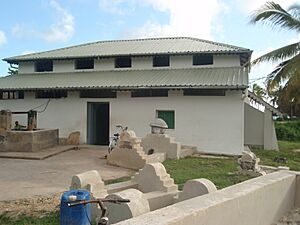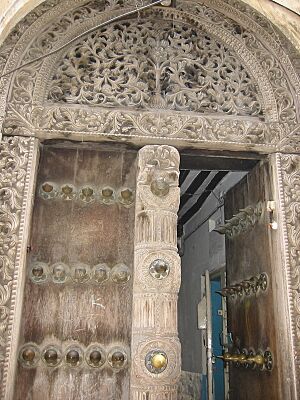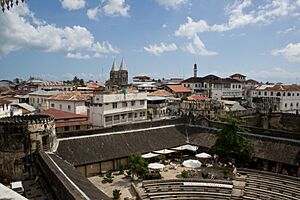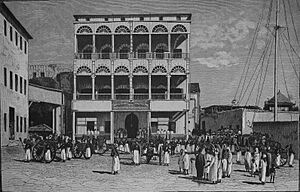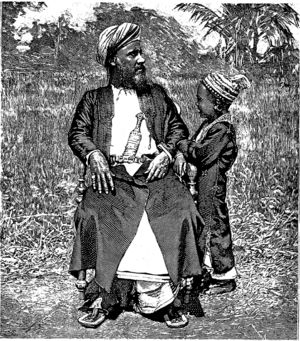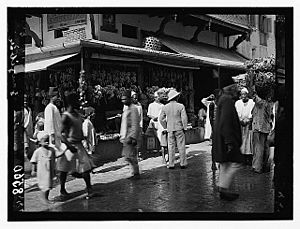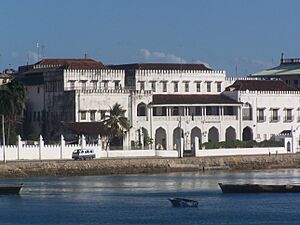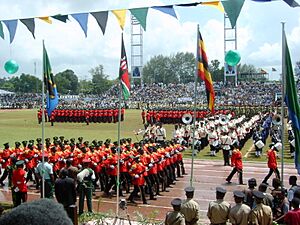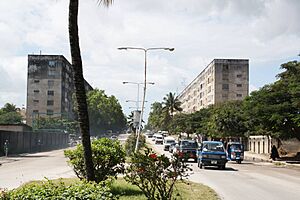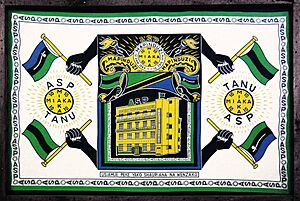History of Zanzibar facts for kids
People have lived in Zanzibar for a very long time, over 20,000 years! The first written stories about Zanzibar began when these islands became a busy stop for traders. These traders traveled between the African Great Lakes, the Somali Peninsula, the Arabian peninsula, Iran, and India.
The island of Unguja had a safe and easy-to-defend harbor. Even though the islands didn't have many valuable goods themselves, people from Oman and Yemen settled in what is now Zanzibar City (also called Stone Town). It was a perfect spot to trade with other towns along the Swahili Coast. They built military bases on the islands and created the first mosques in the African Great Lakes Region.
During the Age of Exploration, the Portuguese Empire was the first European power to take control of Zanzibar. They ruled for almost 200 years. But in 1698, Zanzibar came under the control of the Sultanate of Oman. Under Omani rule, Zanzibar's economy grew, focusing on trade and special cash crops. The rulers were Arabs, and most of the people were Bantu. Large farms were set up to grow spices, which is why Zanzibar became known as the Spice Islands. This name was also used for another Dutch colony, the Moluccas, which is now part of Indonesia.
Another important trade item was ivory, which came from elephant tusks. These elephants were hunted on the Tanganyika mainland. A third big part of the economy was the trade of enslaved people. The Zanzibar slave trade was a major part of the Indian Ocean slave trade, similar to the well-known Triangular Trade in the Atlantic. The Omani Sultan of Zanzibar controlled a large part of the African Great Lakes coast, called Zanj, and also many trading routes far inland.
Over time, the British Empire slowly gained control of Zanzibar. In 1890, Zanzibar became a British protectorate. Later, when one sultan died and the British didn't approve of the new ruler, it led to the Anglo-Zanzibar War. This war is famous for being the shortest war in history!
The islands became independent from Britain in December 1963, becoming a constitutional monarchy with a sultan. Just a month later, the Zanzibar Revolution happened. This event led to the formation of the People's Republic of Zanzibar. In April of that year, the republic joined with mainland Tanganyika. This union formed Tanzania, and Zanzibar remains a semi-autonomous region within it. In recent years, Zanzibar has experienced political disagreements and some violence related to elections.
Contents
Early History of Zanzibar
Zanzibar has been home to people for a very long time, possibly since the Paleolithic period (the Old Stone Age). In 2005, scientists found old stone tools at Kuumbi Cave in southeastern Zanzibar. These tools showed that people lived there at least 22,000 years ago. Other discoveries in a limestone cave, using radiocarbon dating, showed people lived there from around 2800 BC to 1 AD.
Archaeologists found objects like glass beads from around the Indian Ocean. This suggests that early trade networks existed across the ocean, even though some experts are unsure about this.
There is strong evidence that farming and iron-working communities, who were ancestors of the Bantu, lived on Zanzibar from the mid-first millennium AD. This marked the beginning of towns there, with buildings made of mud and wood. This happened earlier than in other parts of the Swahili Coast, where towns appeared around the 9th century AD.
The first permanent residents of Zanzibar seem to have been the ancestors of the Hadimu and Tumbatu people. They started arriving from the African Great Lakes mainland around 1000 AD. They belonged to different Bantu groups from the mainland. On Zanzibar, they lived in small villages and didn't form large, central governments. Because they weren't centrally organized, it was easier for outsiders to take control.
Ancient Trade Routes
Ancient pottery found in Zanzibar shows that trade routes existed with places like ancient Sumer and Assyria a very long time ago. An old pendant found near Eshnunna, dating back to 2500-2400 BC, has been linked to copal (a type of tree resin) imported from the Zanzibar region.
Traders from Arabia (mostly Yemen), the Persian Gulf region of Iran (especially Shiraz), and west India likely visited Zanzibar as early as the 1st century AD. Later, Somalis came during the Middle Ages when Islam became important. These traders used the monsoon winds to sail across the Indian Ocean. They landed at the safe harbor where Zanzibar Town is today. Even though the islands didn't have many resources that interested traders, they were a great place to connect and trade with towns along the Swahili Coast.
From the 10th century AD, towns started to develop, and stone was used more in building. Traders began to settle in small numbers on Zanzibar in the late 11th or 12th century. They married local Africans, mixing their cultures. Eventually, a hereditary ruler, known as the Mwenyi Mkuu or Jumbe, emerged among the Hadimu people. A similar ruler, called the Sheha, was set up among the Tumbatu. These rulers didn't have a lot of power, but they helped strengthen the unique identity of their people.
The Yemenis built the earliest mosque in the southern hemisphere in Kizimkazi. This is the southernmost village in Unguja. An old inscription on its mihrab (a special niche in a mosque) shows the date 1107 AD.
Portuguese Rule
Vasco da Gama's visit in 1499 marked the beginning of European influence in Zanzibar. In 1503 or 1504, Zanzibar became part of the Portuguese Empire. Captain Ruy Lourenço Ravasco Marques landed there and demanded payment from the sultan in exchange for peace. Zanzibar remained under Portuguese control for almost 200 years.
Zanzibar Sultanate
In 1698, Zanzibar came under the control of the Sultan of Oman. The Portuguese were forced out. A profitable trade in enslaved people and ivory grew, along with a growing farming economy focused on cloves. With an excellent harbor and plenty of fresh water, Stone Town (the capital of Zanzibar) became one of the largest and richest cities in East Africa.
Under Omani rule, the most fertile land was given to Omani aristocrats. They used enslaved people to work on these farms. Every year, hundreds of traditional sailing ships called dhows would sail across the Indian Ocean from Arabia, Persia, and India. They brought iron, cloth, sugar, and dates. When the monsoon winds changed direction in March or April, the traders would leave, with their ships full of tortoiseshell, copal, cloves, coconuts, rice, ivory, and enslaved people.
The Arabs set up military bases in Zanzibar, Pemba, and Kilwa. Arab rule was strongest during the time of Sultan Seyyid Said. In 1840, he moved his capital from Muscat, Oman, to Stone Town. He created a ruling Arab group and encouraged the growth of clove farms, using enslaved labor on the island. Zanzibar's trade increasingly fell into the hands of traders from India, whom Said encouraged to settle on the island.
After Sultan Said died in 1856, his sons argued over who would rule next. On April 6, 1861, Zanzibar and Oman were divided into two separate areas. Sayyid Majid bin Said Al-Busaid (1834/5–1870), his sixth son, became the Sultan of Zanzibar. His third son, Sayyid Thuwaini bin Said al-Said, became the Sultan of Oman.
Visitors to Zanzibar often wrote about the beauty of the place. The British explorer Richard Francis Burton described Zanzibar in 1856 as: "Earth, sea and sky, all seemed wrapped in a soft and sensuous repose...The sea of purist sapphire...lay looking...under a blaze of sunshine." The shining white minarets of mosques and the sultan's palaces in Stone Town made the city look like a beautiful "Orientalist" dream from a distance. However, those who got closer described Stone Town as a very smelly city. The British explorer Dr. David Livingstone, who lived in Stone Town in 1866, wrote in his diary: "The stench arising from a mile and a half or two square miles of exposed sea beach, which is the general depository of the filth of the town is quite horrible...It might be called Stinkabar rather than Zanzibar." Besides the bad smell, visitors also described a city where many enslaved people were suffering and where diseases like cholera and malaria were common.
Of all the economic activities in Zanzibar, the trade of enslaved people was the most profitable. All the Black people living on the island were Bantu people brought from the mainland. The enslaved people were brought to Zanzibar in dhows, packed in with no concern for their well-being. Many did not survive the journey. Once in Zanzibar, they were prepared for sale.
Each year, about 40,000-50,000 enslaved people were brought to Zanzibar. About one-third went to work on clove and coconut farms in Zanzibar and Pemba. The rest were sent to Persia, Arabia, the Ottoman Empire, and Egypt. Conditions on the farms were so difficult that about 30% of the male enslaved people died each year, which kept the demand for more enslaved people high.
The Sultan of Zanzibar controlled a large part of the African Great Lakes Coast, known as Zanj. He also controlled trade routes that went much further across the continent, as far as Kindu on the Congo River. In November 1886, a German-British group set the boundaries of Zanj as a 19 km wide strip along most of the African Great Lakes coast. This stretched from Cape Delgado (now in Mozambique) to Kipini (now in Kenya), including Mombasa and Dar es Salaam, and several islands in the Indian Ocean. However, from 1887 to 1892, all these mainland areas were lost to the colonial powers of the United Kingdom, Germany, and Italy. Britain gained control of Mombasa in 1963.
In the late 1800s, the Omani Sultan of Zanzibar also briefly claimed to control Mogadishu in the Horn of Africa and southern Somalia. However, the real power there remained with a strong Somali kingdom, the Geledi Sultanate. In 1892, the Geledi ruler, Osman Ahmed, leased the city to Italy. The Italians eventually bought the rights in 1905 and made Mogadishu the capital of the newly formed Italian Somaliland.
Zanzibar was famous worldwide for its spices and its role in the trade of enslaved people. In the 19th century, Zanzibar was known as a "fabled land of spices, a vile center of slavery, a place of origins of expeditions into the vast, mysterious continent." It was the main port for trading enslaved people in the African Great Lakes region. In the 19th century, as many as 50,000 enslaved people passed through Zanzibar's markets each year. Tippu Tip was a very well-known trader of enslaved people, and also a plantation owner and governor under several sultans.
Zanzibar's spices attracted ships from as far away as the United States, which opened a consulate there in 1837. The United Kingdom became interested in Zanzibar for both trade and to end the Zanzibar slave trade. In 1822, the British signed the first of several agreements with Sultan Said to reduce this trade. Under strong British pressure, the trade of enslaved people was officially stopped in 1876. However, slavery itself remained legal in Zanzibar until 1897.
Zanzibar had the first steam locomotive in the African Great Lakes region. Sultan Bargash bin Said ordered a small train to pull his royal carriage from town to his summer palace at Chukwani. One of the most famous palaces built by the Sultans was the House of Wonders, which is now a popular tourist attraction in Zanzibar.
British Influence and Rule
The British Empire slowly took more control. This was made official by the 1890 Heligoland-Zanzibar Treaty. In this treaty, Germany agreed not to interfere with British interests in Zanzibar. This treaty made Zanzibar and Pemba a British protectorate (meaning Britain protected and advised it, but it wasn't a full colony). British rule, carried out through a sultan, mostly stayed the same.
When Hamad bin Thuwaini died on August 25, 1896, Khalid bin Bargash, the eldest son of the second sultan, Barghash ibn Sa'id, took over the palace and declared himself the new ruler. This went against the wishes of the British government, which preferred Hamoud bin Mohammed. This led to a conflict, later called the Anglo-Zanzibar War, on the morning of August 27. Ships of the Royal Navy destroyed the Beit al Hukum Palace after giving Khalid one hour to leave. He refused, and at 9 am, the ships started firing. Khalid's troops fired back, and he fled to the German consulate. A cease fire was called 45 minutes after the fighting began, making it the shortest war in history. Hamoud was declared the new ruler, and peace returned. Following British demands, he ended Zanzibar's role as a center for the centuries-old trade of enslaved people in 1897 by banning slavery and freeing the enslaved people, while compensating their owners. Hamoud's son and future ruler, Ali, was educated in Britain.
From 1913 until Zanzibar gained independence in 1963, the British appointed their own representatives, who were like governors. One of the good changes brought by the British was the establishment of proper systems for sewers, garbage disposal, and burials.
Independence and Revolution
On December 10, 1963, Zanzibar became independent from the United Kingdom. It was a constitutional monarchy under the Sultan. This didn't last long. On January 12, 1964, the Sultan and the elected government were overthrown in the Zanzibar Revolution. This revolution was led by John Okello, a citizen from Uganda, and his followers. Sheikh Abeid Amani Karume was named president of the new People's Republic of Zanzibar. During this time, many people of Arab and Indian descent were killed, and thousands more were forced to leave or had their property taken.
The new government took control of the local branches of two foreign banks, Standard Bank and National and Grindlays Bank. These became the basis for the new Peoples Bank of Zanzibar. Jetha Lila, the only local bank, closed because many Indian customers left the island.
A main result of the revolution was to break the power of the Arab and Asian ruling class, who had been in charge for about 200 years. Even after joining with Tanganyika, Zanzibar kept its own Revolutionary Council and House of Representatives. Until 1992, it was a one-party system and had power over local matters. The local government is led by the President of Zanzibar, with Karume being the first. This government used the revolution's success to make changes across the island. Many of these changes involved taking power away from Arabs. For example, the Zanzibar civil service became almost entirely African, and land was given from Arabs to Africans. The revolutionary government also started social changes like free healthcare and opening up education to African students, who had only been a small percentage of secondary school students before the revolution.
The government sought help from the Soviet Union, East Germany, and China for projects and military advice. Some projects, like the New Zanzibar Project (a plan to build new apartments for all Zanzibaris in 1968), didn't succeed. This led Zanzibar to focus more on Chinese aid. The post-revolution government was accused of strict controls on personal freedoms and travel. It also showed favoritism in appointing people to political and industry jobs, and the new Tanzanian government couldn't stop it. Dissatisfaction with the government grew, leading to the assassination of Karume on April 7, 1972. This was followed by weeks of fighting.
A multi-party system was finally set up in 1992. However, Zanzibar still faces accusations of corruption and vote-rigging. The 2010 general election was seen as a big improvement.
The revolution itself is still an important event for Zanzibaris and for historians. Historians have studied the revolution, seeing it as having both racial and social reasons. Some say the African revolutionaries were like the working class rebelling against the ruling and trading classes (Arabs and South Asians). Others disagree, saying it was more of a racial revolution made worse by economic differences between groups.
In Zanzibar, the revolution is a key cultural event. It's celebrated every year on January 12, which is a public holiday in Tanzania.
Union with Tanganyika
On April 26, 1964, the mainland area of Tanganyika joined with Zanzibar to form the United Republic of Tanganyika and Zanzibar. This long name was later shortened to the United Republic of Tanzania on October 29, 1964. After joining, local matters in Zanzibar were controlled by President Abeid Amani Karume, while foreign affairs were handled by the United Republic in Dar es Salaam. Zanzibar remains a semi-autonomous region within Tanzania.
Zanzibar's special self-governing status is sometimes compared to Hong Kong, and it has even been called the "African Hong Kong" by some experts.
The Zanzibar House of Representatives was created in 1980. Before this, the Revolutionary Council handled both the executive and law-making duties for 16 years after the Zanzibar Revolution in 1964.
Zanzibar in the 21st Century
There are many political parties in Zanzibar. The most popular ones are the Chama Cha Mapinduzi (CCM) and the Civic United Front (CUF). Since the early 1990s, Zanzibar's politics have seen repeated disagreements between these two parties.
Here are the results of some past elections held under the multi-party system:
| Political Party | Election Year | |||||||
|---|---|---|---|---|---|---|---|---|
| 1995 | 2000 | 2005 | ||||||
| Chama Cha Mapinduzi (CCM) | 26 | 34 | 30 | |||||
| Civic United Front (CUF) | 24 | 16 | 19 | |||||
| Total | 50 | 50 | 50 | |||||
Disputed elections in October 2000 led to clashes on January 27, 2001, resulting in deaths and injuries. About 2,000 people temporarily fled to Kenya.
More disagreements happened after another disputed election on October 31, 2005. The CUF claimed that their rightful victory had been taken from them. Nine people were killed.
After 2005, the two parties tried to negotiate to solve the tensions and create a power-sharing agreement, but they faced many difficulties. A notable setback happened in April 2008 when the CUF left the talks after the CCM called for a public vote to approve what had been presented as a final deal.
In November 2009, the then-president of Zanzibar, Amani Abeid Karume, met with the CUF secretary-general Seif Sharif Hamad. They discussed how to prevent future political problems and end the disagreements between them. Many people, including the United States, welcomed this step. It was the first time since the multi-party system began in Zanzibar that the CUF agreed to recognize Karume as the legitimate president of Zanzibar.
A plan to change Zanzibar's constitution to allow rival parties to form governments of national unity was approved by 66.2 percent of voters on July 31, 2010.
Today, the Alliance for Change and Transparency-Wazalendo (ACT-Wazalendo) is considered the main opposition political party in semi-autonomous Zanzibar. Zanzibar's constitution requires the party that comes in second place in elections to join a coalition with the winning party. ACT-Wazalendo joined a coalition government with the ruling party, Chama Cha Mapinduzi, in December 2020 after the disputed elections.
Leaders of Zanzibar
Sultans of Zanzibar
- Majid bin Said (1856–1870)
- Barghash bin Said (1870–88)
- Khalifah bin Said (1888–90)
- Ali bin Said (1890–93)
- Hamad bin Thuwaini (1893–96)
- Khalid bin Barghash (1896)
- Hamud bin Muhammed (1896–1902)
- Ali bin Hamud (1902–11; gave up his rule)
- Khalifa bin Harub (1911–60)
- Abdullah bin Khalifa (1960–63)
- Jamshid bin Abdullah (1963–64)
British Viziers
- Sir Lloyd William Matthews (1890 to 1901)
- A.S. Rogers (1901 to 1906)
- Arthur Raikes (1906 to 1908)
- Francis Barton (1906 to 1913)
British Residents
- Francis Pearce (1913 to 1922)
- John Sinclair (1922 to 1923)
- Alfred Hollis (1923 to 1929)
- Richard Rankine (1929 to 1937)
- John Hall (1937 to 1940)
- Henry Pilling (1940 to 1946)
- Vincent Glenday (1946 to 1951)
- John Rankine (1952 to 1954)
- Henry Steven Potter (1955 to 1959)
- Arthur George Mooring (1959 to 1963)
Images for kids
See also
 In Spanish: Historia de Zanzíbar para niños
In Spanish: Historia de Zanzíbar para niños
- Timeline of Zanzibar City



